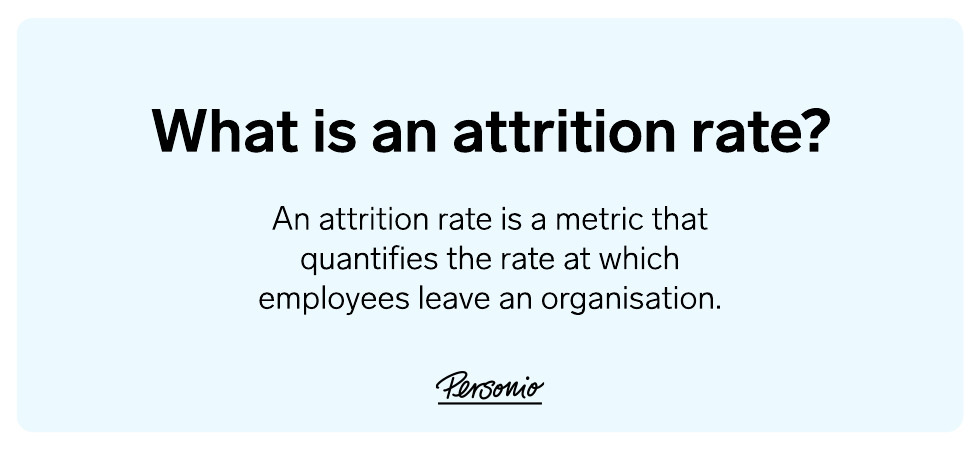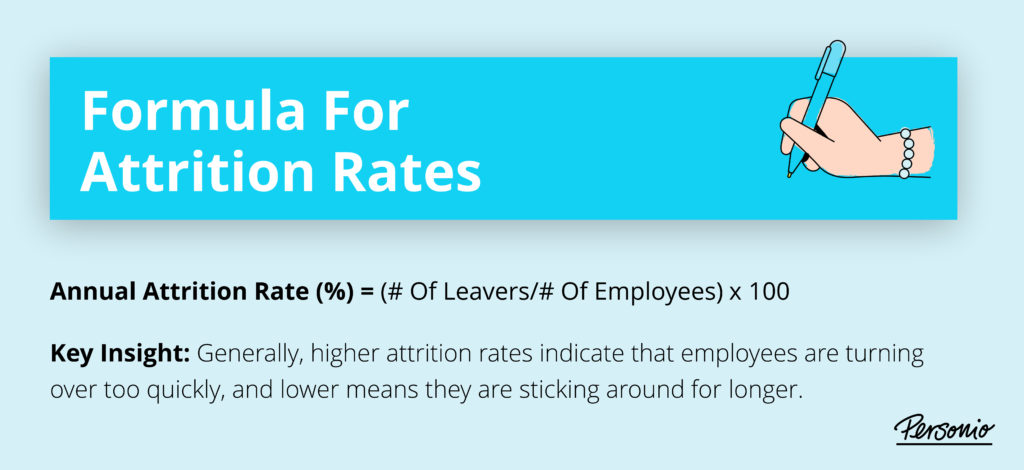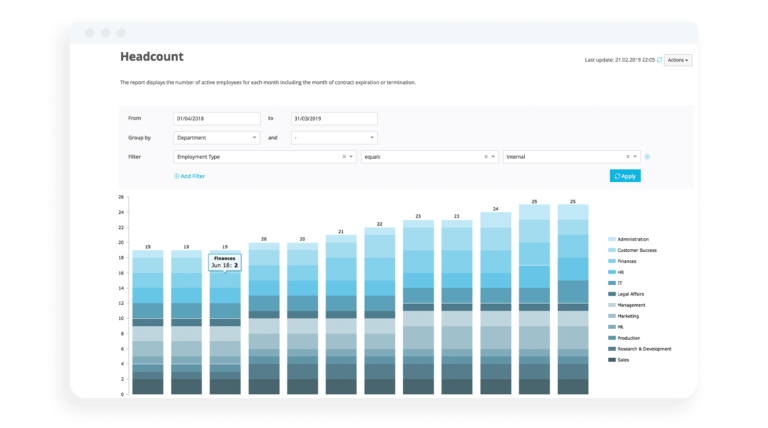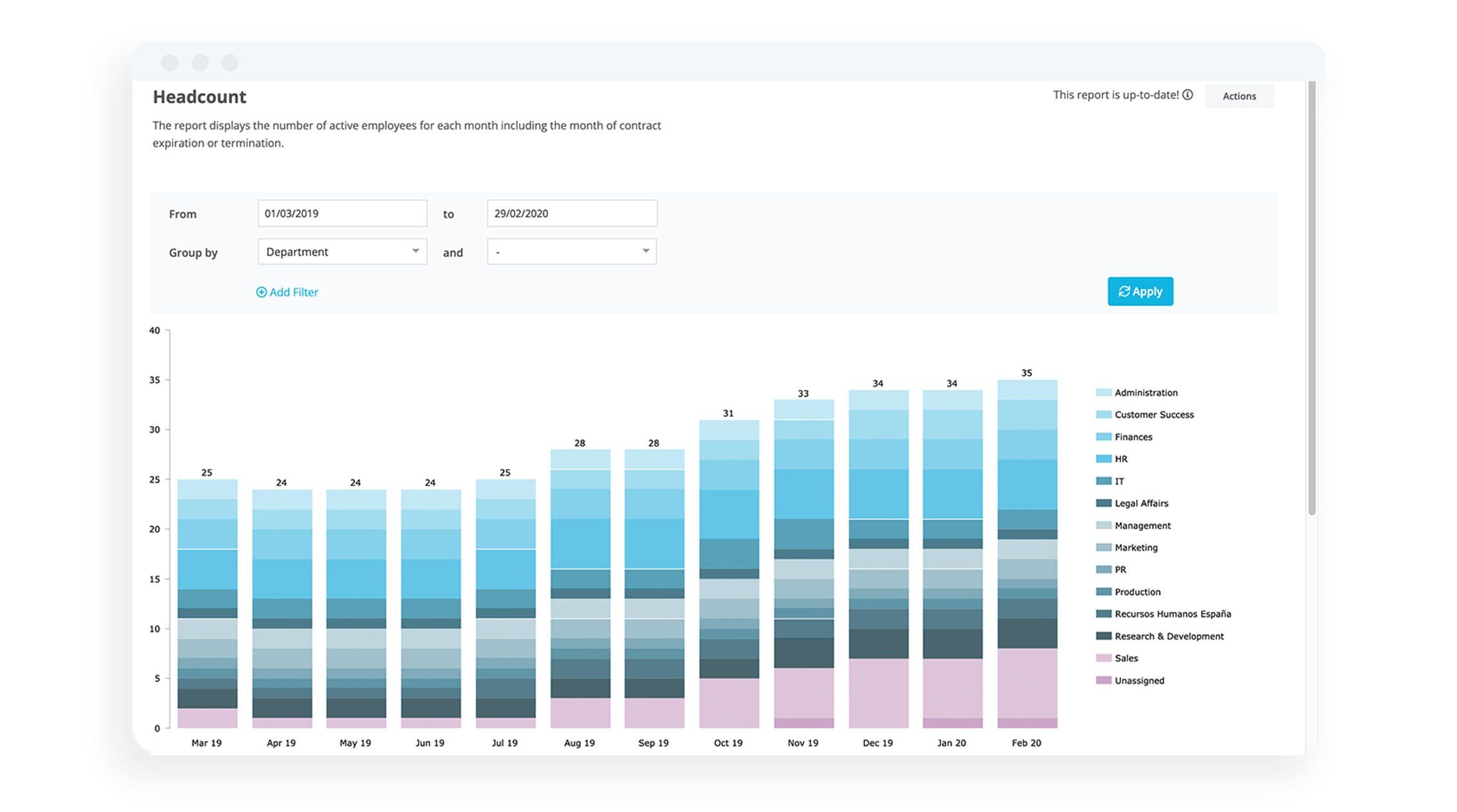Employee Attrition Rate: Understand, Calculate & Improve It

What is your company's attrition rate trying to tell you? Employee attrition is a serious matter. In fact, a high one may mean something in your organisation needs to change immediately. Or if it’s growing over time, it may be reflecting a deep, concerning problem with your organisation and company culture.
Either way, when one employee leaves, it's a shame. When a lot of them leave, though, that’s a concern. In this blog, we offer helpful guidance on identifying different kinds of attrition, as well as correcting a rate that is getting out of control.
Check critical workforce insights, like atrition rates in seconds.Contents
- 1What is attrition rate?
- 2The four key different types of attrition
- 3Why does your attrition rate matter?
- 4Try it: employee attrition rate calculator & formula
- 5What is considered a ‘high’ employee attrition rate?
- 6What is influencing your attrition rate?
- 7When should you focus on employee attrition?
- 8Staff attrition: best practices for when employees leave
What is attrition rate?
Attrition rate is a metric that quantifies the rate at which employees depart an organisation, whether voluntarily or involuntarily. It represents the pace of employee turnover, expressed as a percentage and serves as a key indicator for HR teams to evaluate retention efforts and understand organisational dynamics.
How do you calculate attrition rate?
Take the number of people who have left the company, divide that by the average number of employees over a period of time. It is often expressed as a percentage (%).
The four key different types of attrition
There are different kinds of attrition, though. They are as follows:
Type of attrition | What it means |
|---|---|
Voluntary attrition | When an employee chooses to leave |
Involuntary attrition | When an employee is dismissed |
Internal attrition | When employees move internally |
Demographic-specific attrition | When a specific group (age, gender, ethnicity) leaves |
Which types of employee attrition are worst?
Most notably, concerning types of attrition are voluntary and demographic-specific attrition. That’s because both of these may be pointing to structural issues within your organisation.
The first, voluntary attrition, could point to flaws in the way you nurture employees. They may be leaving because they are not getting what they need, what they want, or are not satisfied in their roles. Having an idea of the ‘why’ behind an employee leaving, typically through an employee exit interview, is typically a good place to start.
In addition, demographic-specific attrition can also be a cause for concern. That’s because it could speak to a toxic type of corporate culture that could be harming your company from the inside out. Diversity management is crucial here and a company lacking in it may have significant internal issues worth interrogating.
Why does your attrition rate matter?
Staff turnover can have a negative impact on your company’s performance. That is why it’s important to know the status of your attrition rate. The first impact can be felt in hiring cost. After all, replacing a highly-trained employee can vary between 120% of their annual salary to more than 200%, according to some sources.
Unless there is an extremely rigorous handover process, institutional knowledge will leave the organisation. That’s because it is almost impossible to transfer all the knowledge an employee has gained over the years. This is true, of course, unless you have a next-level succession planning process in place.
Their departure will also impact those people working around them. Often, that results in adding more work to already over-burdened team members. Their departure can also reduce morale, increase stress, burn out employees and perhaps even impact the company’s overall business performance.
Whenever someone leaves it definitely changes the dynamics of a team and can even hurt the company’s employer brand and even employer value proposition (EVP). For example, recruiters often say that they struggle to recruit new people when the company has a history of high turnover.
What’s the difference between attrition and turnover?
Although these terms are often used interchangeably, some suggest that attrition is more of a long-term concept. Most often, staff turnover is addressed by hiring people to fill gaps as quickly as possible. In that case, turnover means to bandage the ‘wound’ to your organisation, whereas attrition is a signal to treat the potential root cause.
HR Toolbox, for example, defines them separately saying that "vacancies left by attrition aren’t immediately filled up. Turnover, in contrast, is a more short-term metric.”
Looking to calculate your staff turnover rate? Download our template for some help.
Try it: employee attrition rate calculator & formula

Regardless of whether you call it employee attrition or churn (or less accurately, turnover), it’s important to know how to calculate employee attrition.
So here’s an example: Let’s say you ended the year with 200 employees in your organisation. But, in that same time, 40 employees left. The result would be the following:
Annual attrition rate = (# of leavers/# of employees) x 100 Annual attrition rate = (40/200) x 100 Annual attrition rate = (0.2) x 100 Annual attrition rate = 20%
You can also get more specific though and look at turnover within a precise timeframe. This could result in gaining a handle on early attrition, attrition that occurs within the first 90 days of employment (within the probation period).
An example of this could look like the following. Let’s say that you had 60 employees join your organisation within a 90-day period and 15 of them quit during that same time. Here’s how it might look:
Early attrition rate = (# of leavers/# of employees) x 100 Early attrition rate = (15/60) x 100 Early attrition rate = (0.25) x 100 Early attrition rate = 25%
The point is to try and get your attrition rate formula to create the most accurate picture of attrition within your organisation. But having an HR software that can grab these reports in an instant is a big help.
Click here to learn more about HR analytics with Personio.
What is considered a ‘high’ employee attrition rate?
Generally, high attrition rates or churn rates indicate that employees are turning over pretty quickly while low attrition rates mean that people are staying with your company for a longer period of time.
Employee attrition rates will also vary based on the size of your company. That said, if you have an attrition rate that is over 20% throughout the course of a year, then your team may want to dig into the numbers.
Additionally, if your early attrition rate, the rate of new joiners leaving within their first six months of employment, is north of 15%, you may want to look into your onboarding processes (simply to make sure everyone is getting up to speed quickly).
Personio offers a seamless employee onboarding solution that can help.
What does a 10% attrition rate mean?
This figure means for example that for every 100 employees you have, 10 will leave over the course of a year. Similarly, if you have 50 employees in total, then five will leave. It is the fraction of people who will leave in relation to the full number of employees currently employed in your organisation.
Keep in mind: attrition rates vary wildly
According to a source quoting the US Bureau of Labor Statistics: “About 3 million Americans quit their job each month.”
This is not the norm worldwide, though. It is very important to remember that attrition rates vary widely across sectors, countries and job types. So, while Monster says that the UK average employee turnover rate is approximately 15% a year, in 2018 LinkedIn reported from their own data that the global average was 10.9%.
They also reported very wide ranges of turnover, even within specific industries. For example, in one LinkedIn survey, software/technology businesses had an average turnover rate of 13.2% at the time, but user experience designers specifically turned over at 23.3%, while the e-learning sector showed a turnover trend of only 11.6%.
As a further illustration of the diversity of attrition rates, a survey by XpertHR published in 2019 indicated that the average turnover for sales and marketing staff was as high as 31%, while only 17.2% of HR staff turned over and engineers specifically only turned over at a rate of 8.8%.
This image below, adapted from the Science of Work, helps put attrition rates into perspective…
HR best practices: other KPIs to keep in mind
Is your HR looking to dive deeper into analytics and reports for your organisation? Here’s a quick run-through of some other articles we think you might find helpful:
Best practice: find out why people are leaving
While your company’s attrition rate is important – especially if the number has changed significantly over a period of time – what’s more important is to know why employees are leaving in the first place.
If employees leave because they have to – they’re moving to a new city, they’re changing careers, their family circumstances are forcing them to change – then there’s nothing that you, as a company, can do about it.
That said, employees don’t just leave because they have to. They may be pushed, whether intentionally or because there’s something in your business that isn’t quite right. If that happens, it is worth paying attention to what made them decide to leave so you can fix it.
Check your attrition rate instantly

Empower your team with HR software that can generate standard and custom reports in only a few clicks on everything from attrition rate to headcount.
Learn moreWhat is influencing your attrition rate?
Figuring out why employees are leaving is critical to improving your attrition rate.
That’s partly why many companies do exit interviews: employees are more likely to be honest about what they didn’t like about the company. Or, about what went wrong once they have a secure position somewhere else.
When they leave it’s helpful to ask questions about:
Potential factor | Ask yourself |
|---|---|
Managers | Are managers properly motivating employees? |
Team atmosphere | Is culture a major factor for leaving? |
Recognition programs | Does an employee feel recognized for their work? |
Pay & benefits | Is your company adequately compensating employees? |
Mental health | Are stress and workload major issues? |
Workforce demographics | Does your company have a diversity problem? |
Check out these metrics for measuring and tracking employee wellbeing today.
People often leave in order to get a promotion, salary increases, or to a company with a better career progression framework. Therefore, money is often a contributing factor. But, there’s also a saying that goes: ‘People don’t leave jobs, they leave bosses.’
Having a good manager is very important to employee satisfaction. That said, employees don’t just leave because of their managers, they leave because of the role and the value they find in their work.
Employees are more likely to leave a job if the responsibilities of the role are ambiguous. Or, if the job is made up of seemingly unimportant tasks and if they don’t feel that what they do is meaningful.
Is a high attrition rate good?
A low attrition rate isn’t always a good thing. Some companies with low attrition rates become stale over time without new people bringing in new ideas. Similarly, it can be difficult to get a challenging employee to leave a business.
If they’re a poor cultural fit for the business or their job it can reduce productivity and morale across the business. It may be a good thing if they leave. In most cases though, a high attrition rate is usually bad.
When should you focus on employee attrition?
Awareness of your attrition rate is most certainly a good thing.
That’s because it allows you to identify how many employees are leaving and why they are leaving. If you have a high employee turnover rate, pay attention to it.
Fixing underlying issues can help improve business:
Potential Issues | Potential Solutions |
|---|---|
Performance | Can you implement a framework to help employees develop? |
Productivity | Are there tools that can help employees focus on their work and not admin? |
Morale | Do you need to put your culture in focus and create values? |
Download our definitive guide to corporate culture for organisations here.
However, a change of employees can also be an opportunity for the business. It allows you to restructure a team or a department and possibly even save costs. This can be done either by hiring more junior people, splitting the role up among other team members, or promoting someone internally.
The important thing to remember is that a high attrition rate shouldn’t cause concern for no good reason. Make sure to first compare the rates within your industry and country averages. In fact, what may seem alarming might be quite commonplace.
The thing to be aware of is what happens when attrition rates start to increase. That’s when it’s time to interrogate your employee data thoroughly and to make changes, without haste.
Staff attrition: best practices for when employees leave
While it does hurt to lose talented employees and it’s expensive to replace them, it’s also wise to let them go graciously and painlessly. It’s easier if employees’ records are up-to-date, easy to locate and you have the right termination processes documented. And, when they are ready to follow.
That’s what makes Personio’s HR analytics and reportingso helpful. It’s a streamlined way to keep your finger on the pulse of your employee satisfaction, with an eye peeled for any dissent, dissatisfaction, or frustrations. This way, you can fix issues before they ever become problems for your top performers.
It’s not only good practice, though. Over time it may help reduce your employee attrition rate and improve employee retention. After all, the idea is to get people on board, keep them happy and help your business thrive. Our mission is to help HR professionals do that every single day.

